A garage is a building, usually not heated. In order for the car to function normally in winter cold, it should not be left overnight in a room where the temperature is significantly higher than outside. In extreme heat or high humidity, the same picture is observed: a large difference between the temperature inside and outside the garage has a bad effect on the operation of the car. Garage door trim is one of the solutions to the problem.
- Why sheathe garage doors
- general information
- Indoor or outdoor work
- Preparing the door leaf
- Tips for individual materials
- Features of various heaters
- Varieties of materials
- Liquid penoizol
- Stone wool
- Mineral wool
- Extruded polystyrene foam
- Sheathing of sliding gates with sandwich panels
- Sheathing of garage doors with plywood
- Door trim
Why sheathe garage doors
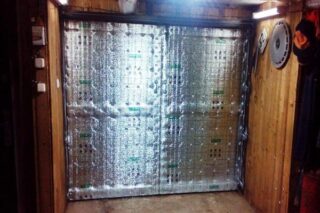
The main task of the garage is to prevent freezing or freezing, and not to create an optimal thermal regime. According to SNiP, it is recommended to maintain a temperature of no more than +5 C in heated parking lots, and not lower than 0 C in unheated ones. To maintain such a regime, in the northern regions, the room will still have to be equipped with a heater. In the middle and southern ones, you can do with insulation.
Insulation performs the following functions:
- Thermal insulation - iron gates are the main cause of heat loss. Insulation of gates and walls allows you to maintain the temperature above zero without heating.
- Overheating protection - too high an indoor temperature is also not good for the car. High-quality thermal insulation in the garage ensures an acceptable temperature regime.
- The absence of drafts is important for those cases when a workshop is being set up in the garage.
- Protection against moisture - according to statistics, being in a damp, warm room is more destructive for a car than outside in winter. Installation of insulation implies reliable waterproofing, which excludes the accumulation of moisture and the appearance of condensation inside.
If there are no windows and vents in the garage, the insulation is combined with the arrangement of good ventilation, forced if necessary.
general information
Insulation of the garage is possible both outside and inside. The choice of installation method, material, finishing method depends on the type of garage, its location, frequency of use and other factors.
Indoor or outdoor work
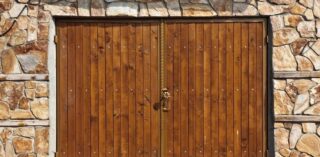
External insulation is considered a more practical option. In order to maintain the optimal temperature and humidity conditions inside the room, each subsequent layer of the wall cake from the inside to the outside must have greater vapor permeability. Since materials with high friability, with open pores are most often taken for thermal insulation, this requirement is much easier to comply with by installing insulation outside.
It is not always possible to sheathe the garage door from the outside. Exceptions:
- If the garage is not an outbuilding in the country, but one of the boxes in a common cooperative structure, this is simply impossible to do. Only the sash is insulated outside, and the rest of the room inside is unprofitable.
- The metal box has high thermal conductivity and zero vapor permeability. It does not matter where the insulation is located, the problem of removing moisture from the room is still solved only with the help of ventilation.
- Not all materials are suitable for outside decoration. Mineral wool is sensitive to moisture. If you insulate it from the outside, you will need very good waterproofing, additional vapor barrier and lathing with a ventilation gap.From the inside, the mats can be attached directly to the wall.
- If the garage is annexed and is part of a building, its exterior finish should be exactly the same as the facade cladding. In this case, it is more rational to do the insulation from the inside.
Often, garage doors are sheathed for the sake of attractiveness. To insulate from the inside, but to trim from the outside is irrational.
Preparing the door leaf
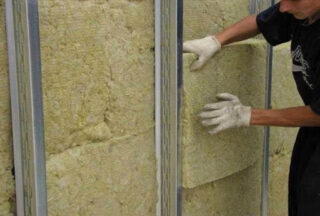
Most often, the garage door and wicket are made of sheet steel with a thickness of about 5 mm. This design allows heat to pass through without delay. But due to the peculiarities of the material, it is more convenient to insulate it from the inside, since it is difficult to fix the waterproofing and crate on a smooth metal surface without damaging it.
Before sheathing garage doors from the outside or from the inside, they must be prepared. Step-by-step scheme of work:
- They clean the surface from dust and dirt. With a metal brush or a drill with a nozzle, remove the old layer of paint, rust stains, if any.
- The gate is treated with a special anti-corrosion primer. The composition creates a waterproof film on the surface, thereby preventing rusting. Use a regular brush or roller in the work.
- Sealing rubber is installed around the perimeter of the door frames. This is a common element of thermal insulation: when closed, the sash fits snugly against the uprights, which excludes the penetration of cold air.
The seal also prevents impacts and damage when opened too abruptly.
Tips for individual materials
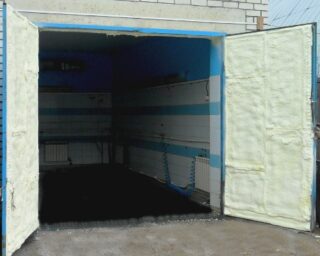
The choice of insulation depends on many factors:
- Gate material - when the steel sheet is insulated, the vapor permeability of the insulation does not matter. If the sash is made of wood, you need to remember: the material for interior decoration must have a lower vapor permeability than wood, and the external one must have a large one, which is quite difficult.
- Design - swing doors or sliding doors are arranged, in fact, the same. Finishing requirements are also similar here. Overhead sectional doors require insulation only from the inside and only with special materials.
- The thickness and amount of heat storage is determined by the weather conditions of the region and the type of the building itself. If this is a brick building with a wall 20-25 cm thick, mineral wool or foam of a small thickness will be required to insulate the gate. Efforts must be made to insulate the metal box.
- it is important to assess the fire hazard of the material. The garage stores a supply of fuel, oil, lubricants and other flammable liquids. Therefore, the requirements for fire safety are very high here. Preference is given to non-combustible materials like basalt or mineral wool.
The easiest and fastest way to insulate a gate is to use a special paint. After drying, a polymer-ceramic film with good heat-saving properties is formed on the surface. The gate is painted in several layers.
Features of various heaters
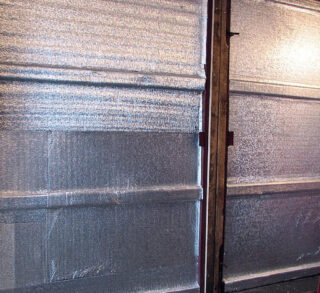
Since the garage is not a living space, it can be insulated with any materials and using any technology. There are 3 categories of heat insulators:
- Plate - produced in the form of sheets with a thickness of 50 mm. They are based on highly porous organic material: penoplex, polystyrene. The main plus is insensitivity to moisture. The downside is the high cost and low vapor permeability. The latter is not very important for interior decoration.
- Rolls - basalt, mineral wool, glass wool. Available in mats and rolls. This material is very loose and soft. It is placed by fixing it in the crate cells, which makes the installation somewhat more difficult. Materials are not afraid of fire, however, they are more sensitive to excess moisture and need waterproofing.
- Sprayed - polyurethane foam, foam insulation. A material like polyurethane foam, when applied, forms a lot of air bubbles in its mass.The substance freezes in air, turning into a solid, highly porous layer, absolutely insensitive to either water or fire. The downside is the high cost and the need to use special equipment for spraying.
For gates, it is recommended to choose materials that are as lightweight and compact as possible, so as not to complicate opening.
Varieties of materials
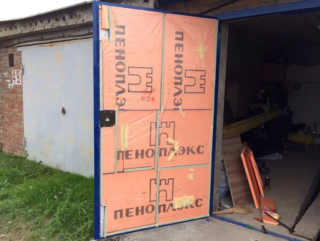
How and how to sheathe garage doors from the inside or outside is decided taking into account the thermal insulation and other characteristics of the material. There is a wide choice on the market.
Liquid penoizol
A kind of sprayed heat insulator. In finished form, it resembles a standard fine-mesh foam. It is applied from a spray can under pressure. Like polyurethane foam, the material fills all joints and irregularities, excluding the appearance of cold bridges. During operation, smoke and toxic substances are not emitted.
Minus: the material is flammable; it is not suitable for thermal insulation of wooden doors.
Stone wool
It is made of rocks and is an array of short and long fibers that form a loose structure. Such a plate is quite rigid, it is easy to put it on the shoulder and does not need additional fastening. Plus - complete fire safety, minus - the material is afraid of water and needs waterproofing.
In the garage, stone wool is preferred to mineral wool, because rodents do not like it.
Mineral wool
Mineral wool means a variant made from slag. Such material is very cheap, however, it is inferior to stone wool in terms of strength, durability, and resistance to moisture. It consists of shorter fibers, which makes it more fragile. Because of this, it gets wet faster and loses its thermal insulation properties.
Low price and high heat saving make mineral wool popular.
Compared to slab or sprayed heat insulators, mineral and basalt wool have a common disadvantage: the material cannot be attached directly to the wall. It is necessary to build a frame, and place mats in the cells.
Extruded polystyrene foam
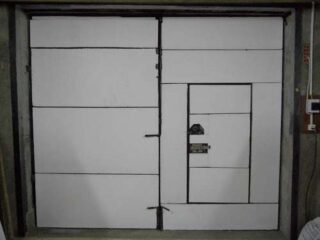
Compared to conventional polystyrene, expanded polystyrene has a looser structure. During its manufacture, a foaming agent is added to the original workpiece. The resulting air bubbles cannot escape from the polymer mass and form a finely porous structure.
Expanded polystyrene is produced in the form of slabs, fixed both on the surface of the sash and in the crate. It is lightweight, not afraid of water, but highly flammable. If the gate or wicket is faced with expanded polystyrene, it is necessary to install fire-resistant fittings here.
Sheathing of sliding gates with sandwich panels
This is an option for ready-made insulated gates that you just need to install. The fabric of the product is assembled from sandwich panels. The panel consists of a polyurethane foam plate between two sheets of galvanized steel with a thickness of 0.45 mm. From above, the structure is primed and covered with polymer paint, which protects the steel from corrosion.
Such gates do not need additional insulation and waterproofing. The manufacturer provides at least 10 years of warranty.
Sheathing of garage doors with plywood
In regions with relatively warm climates, the interior decoration material can simultaneously serve as insulation and cladding. Plywood is a perfect example. These are multilayer sheets of thin wood cuts glued together with waterproof glue. The material is durable, lightweight, looks great and has good thermal insulation properties.
Plywood is easy to cut, saw, drill holes in it. It is possible to fit the slabs to the size of the gate or wicket with high accuracy.
Door trim
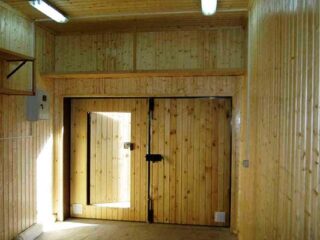
Thermal insulation material rarely looks aesthetically pleasing and even less often does not need protection and camouflage. When insulating a gate, you need to choose a finish.
- Inside, the garage is often sewn up with clapboard.Lightweight wooden lamellas create a pleasant atmosphere, do not emit toxic substances, and are very beautiful. However, the lining needs to be looked after: at least once a year, the finish is treated with antiseptic solutions, varnished.
- OSV, chipboard - thin chipboard. They are attracted by their lightness and simplicity in processing.
- Euroshtaketnik - external cladding. The lamellas, often imitating wood, are made of sheet steel. Zinc and polymer coating protects them from corrosion. Euroshtaketnik is strong, durable and not afraid of fire.
- The profiled sheet possesses the same advantages. Its installation is even easier due to the large sheet dimensions. But in aesthetic terms, such cladding is inferior to the metal "lining".
Do-it-yourself insulation of gates and wickets is an indispensable part of the overall thermal insulation of the garage. Insulation and decoration are chosen depending on the type of building, weather conditions, material of walls and gates.








